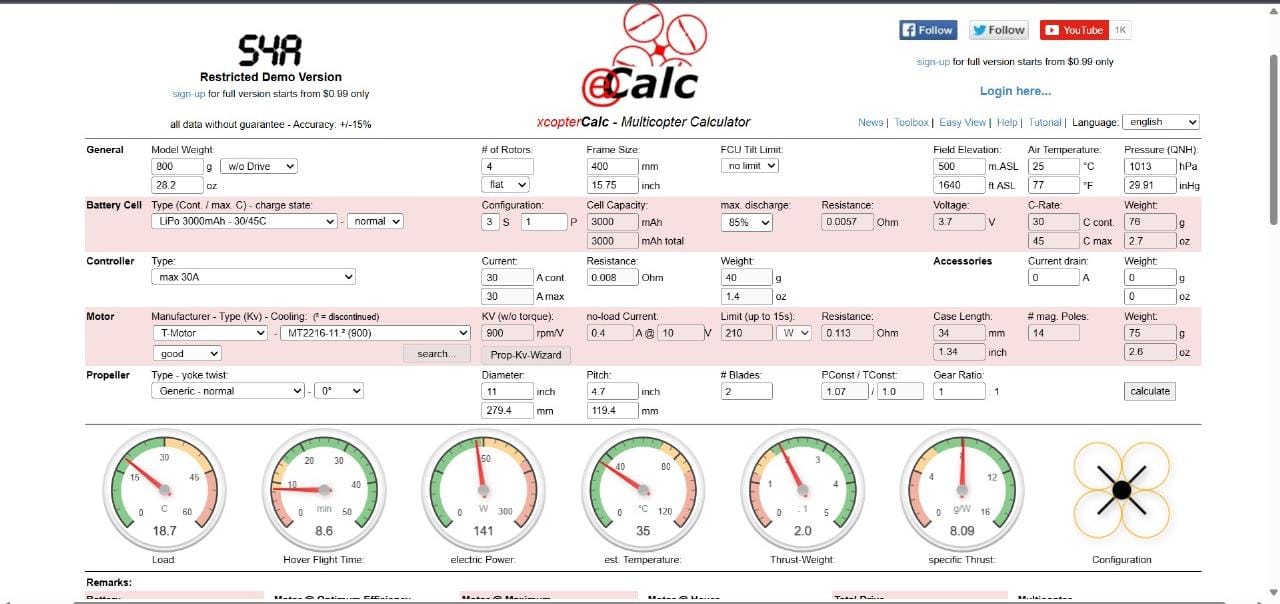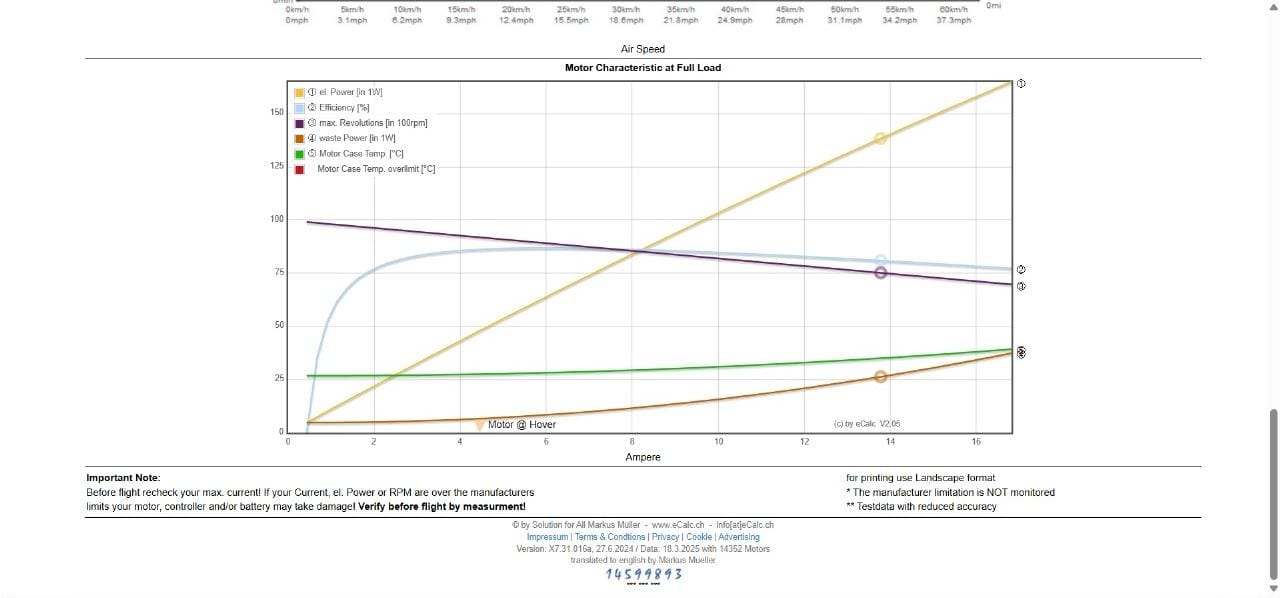Level 1 Report
30 / 3 / 2025
Task 4: Assemble a Drone using eCalc
Introduction
This report documents the design process of a drone with an empty weight of 800 grams using data obtained from eCalc. The aim is to optimize payload capacity, thrust-to-weight ratio, endurance, and overall performance while justifying the selection of materials and components.
Material Selection
The selection of materials is crucial to achieving optimal drone performance. Lightweight and durable materials have been chosen for the frame to ensure stability, while the components like the motor and battery are selected for their compatibility and efficiency in maintaining a balanced performance.
Frame
- Material: Carbon Fiber
- Weight: 200 grams
- Justification: Carbon fiber is chosen due to its excellent strength-to-weight ratio, rigidity, and resistance to deformation, which ensures the drone remains lightweight while being capable of withstanding mechanical stress during flight. Its non-corrosive properties make it ideal for long-term use in various environments.
Motor
- Model: T-Motor MT2216-11^2(900)
- KV Rating: 900 kV
- Justification: This motor provides an optimal balance between power and efficiency, ensuring stable hover and maneuverability. Its yoke twist design enhances stability, and the 900 kV rating allows efficient thrust generation while maintaining low power consumption.
Propellers
- Type: Yoke twist generic normal propeller
- Diameter: 11 inches
- Pitch: 4.7 inches
- Justification: These propellers are selected for their efficiency and compatibility with the motor. The 11-inch diameter and 4.7-inch pitch provide an optimal balance between stability and thrust for general drone use.
Battery
- Type: LiPo, 3S, 3000 mAh, 30/45 C (normal charge)
- Voltage: 3.7 volts
- Max Discharge: 85%
- Justification: The LiPo battery is chosen for its high discharge rate and low weight. The 3000 mAh capacity ensures a sufficient flight time, while the 30/45 C rating allows for quick bursts of power needed during throttle changes. The 3S configuration ensures compatibility with the motor and ESC.
ESC (Electronic Speed Controller)
- Model: max 30A, ESC
- Weight: 40 grams
- Justification: The ESC is selected based on its compatibility with the motor, ensuring proper speed control without overheating or underperformance. The 40-gram weight is accounted for in the overall drone weight to calculate the required thrust.
Results from eCalc
Key Performance Metrics
- Thrust-to-Weight Ratio:
- Achieved: 2:1
- Implication: This ensures stable flight with room for payloads of up to 1132 grams.
- Hover Flight Time:
- Achieved: 8.6 minutes
- Mixed Flight Time:
- Achieved: 6.4 minutes
- Total Weight:
- Frame Weight: 200 grams
- All-Up Weight (including payload): 1557 grams
- Max Speed:
- Achieved: 52 km/h
- Efficiency at Hover:
- Achieved: 81.1%
- Estimated Temperature of Motor:
- At Hover: 28°C
Analysis
Payload and Endurance
The thrust-to-weight ratio of 2:1 provides ample room for payloads while maintaining stable flight. The hover time of 8.6 minutes is ideal for most mid-range applications, ensuring efficient energy use from the battery. The battery’s capacity is optimized for maintaining a balance between weight and endurance, enabling the drone to perform effectively over longer durations.
Component Compatibility
The motor, ESC, and propellers are well-matched, as evidenced by the efficiency and stable RPM performance. The selected battery complements the overall design, allowing sustained operation without overheating. The 40g ESC weight was factored into the overall weight, impacting the required thrust calculations and ensuring the drone's balance and performance remain intact.
Takeaways
- The importance of thrust-to-weight ratio in drone design.
- Understanding the balance between weight, power, and endurance.
- Learning to interpret motor and battery datasheets for optimal selection.
- Familiarization with tools like eCalc



Task 5 - Regulations of DGCA
Introduction
This report covers the regulations governing drone operations in India, focusing on the guidelines set by the Directorate General of Civil Aviation (DGCA). It includes an overview of relevant organizations, drone classification, airspace zones, operational requirements, and the 2021 drone rules.
Key Regulatory Organizations
International Civil Aviation Organization (ICAO)
The ICAO is a specialized agency of the United Nations responsible for setting global aviation standards, including guidelines for drone operations. It establishes Standards and Recommended Practices (SARPs) that member countries adapt into their regulations.
Directorate General of Civil Aviation (DGCA)
DGCA is India's regulatory authority overseeing civil aviation, including drone regulations. It enforces policies for licensing, airworthiness, and operational safety of drones, ensuring compliance with international and national standards.
Quality Council of India (QCI)
QCI ensures compliance with national quality standards across various sectors, including drone manufacturing. It plays a key role in certifying drones and their components for safe and efficient operations.
Bureau of Indian Standards (BIS)
BIS is responsible for setting and maintaining technical standards in India. For drones, it defines safety, quality, and performance standards that manufacturers must follow to receive certification.
Drone Classification
Drones are classified based on their maximum takeoff weight (MTOW):
- Nano (≤250g): No registration required.
- Micro (250g - 2kg): Registration required; some restrictions apply.
- Small (2kg - 25kg): Requires DGCA approval for most operations.
- Medium (25kg - 150kg): Strict regulations apply; requires special permissions.
- Large (>150kg): Requires full compliance with aviation standards and approvals.
Airspace Zones
India has a color-coded airspace classification system for drone operations:
- Green Zone: Automatic flight approval for registered drones.
- Yellow Zone: Permission required from DGCA before operation.
- Red Zone: No drone operations allowed without special government clearance.
Operational Requirements
- Drone operators must register on the Digital Sky Platform.
- Remote Pilot Licenses (RPL) are required for certain categories.
- Safety features like Geo-fencing and Return-to-Home (RTH) are mandatory for most drones.
- No-fly zones include military areas, airports, and national security-sensitive locations.
New Drone Rules 2021
The Indian government introduced new drone rules in 2021 to simplify regulations and encourage growth in the drone sector:
- Reduced paperwork for drone registration and pilot certification.
- Digital Sky Platform for real-time permission tracking.
- Increased permissible payload for commercial use.
- No security clearance required for drone imports.
- Coverage expanded to include drone taxis and advanced air mobility solutions.
Drone Regulation Timeline
- 2014: Initial ban on drones by DGCA due to security concerns.
- 2018: DGCA introduced the first formal drone policy (CAR 1.0).
- 2019: Digital Sky Platform launched to regulate drone operations.
- 2021: New Drone Rules introduced to ease restrictions and support the industry.
Conclusion
Understanding and following DGCA regulations is crucial for safe and legal drone operations in India. These regulations ensure compliance with international standards while allowing for innovation and growth in the drone industry.
